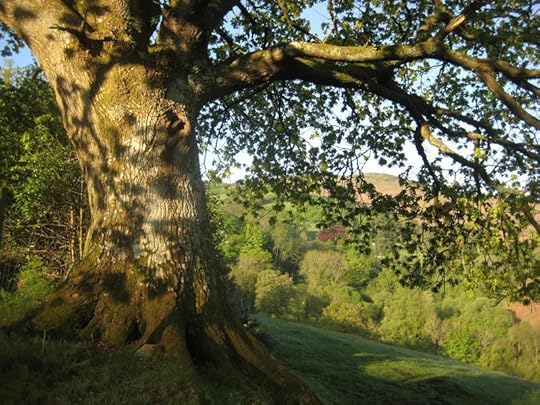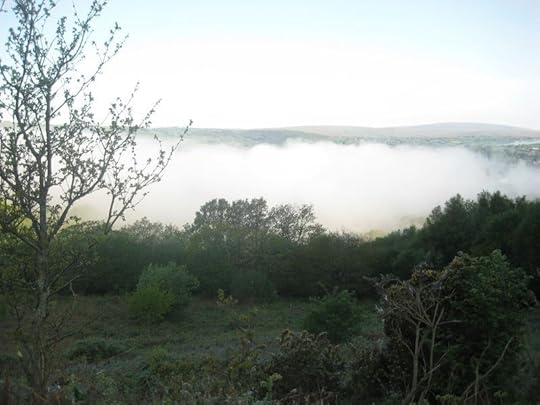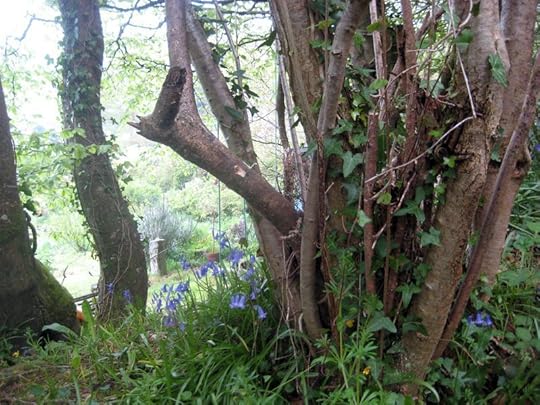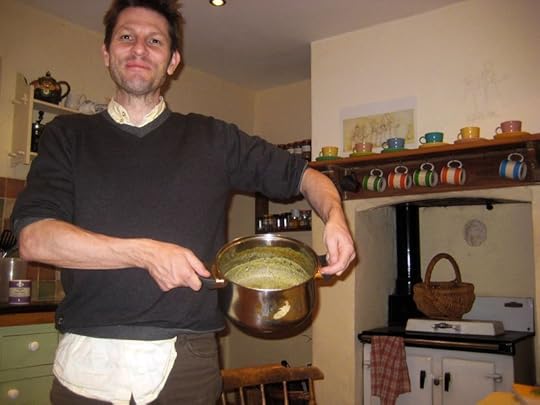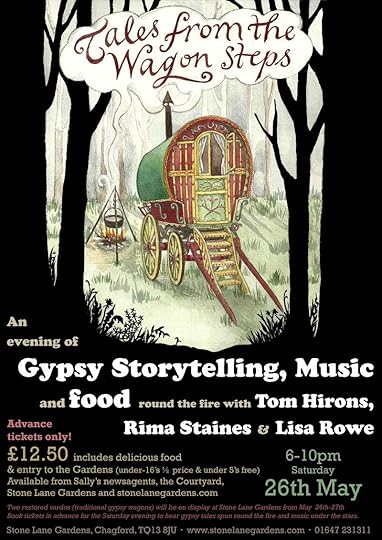Terri Windling's Blog, page 220
June 1, 2012
Take a step
"I always love doors opening. It is part of the reinvention of self that every artist has to do on a daily, monthly, yearly basis. If we don't take that step out, away from the known and into the unknown, if we don't take that step through to back home, then we are wasting our talent and our time on earth.
"Take a step, breathe in the world, give it out again in story, poem, song, art." - Jane Yolen
There is always an opening, always a way through. If one gate is rusted shut or a passage blocked by brambles, move on and find another. Keep working, don't give up. There is always a way...
...into the light.
May 30, 2012
Going deep
"Yet, no matter how deeply I go down into myself, my God is dark, and like a webbing made of a hundred roots that drink in silence." - Rainer Maria Rilke
"Let everything happen to you: beauty and terror. Just keep going. No feeling is final." - Rilke
"Surely all art is the result of one's having been in danger, of having gone through an experience all the way to the end, to where no one can go any further." - Rilke
“The work of the eyes is done. Go now and do the heart-work on the images imprisoned within you.” - Rilke
May 29, 2012
If we surrendered
...If we surrendered
to earth’s intelligence
we could rise up rooted, like trees.
Instead we entangle ourselves
in knots of our own making
and struggle, lonely and confused.
So like children, we begin again...
to fall,
patiently to trust our heaviness.
Even a bird has to do that
before he can fly.
— Rainer Maria Rilke (from the poem "How Sure Gravity's Law," published in Rilke’s Book of Hours, translated from the German by Anita Barrows and Joanna Macy)
Photos: Above, an old tree stands guard at the entrance to a neighbor's field, with Meldon Hill behind (or is it Middle-Earth?) Below, Tilly in the field - surrendering to the intelligence of the earth...as dogs do so well.
May 28, 2012
Early morning mist. Stillness. Silence.
“Were it possible for us to see further than our knowledge reaches, and yet a little way beyond the outworks of our divinings, perhaps we would endure our sadnesses with greater confidence than our joys. For they are the moments when something new has entered into us, something unknown; our feelings grow mute in shy perplexity, everything in us withdraws, a stillness comes, and the new, which no one knows, stands in the midst of it and is silent.”
- Rainer Maria Rilke (Letters to a Young Poet)
Tunes for a Monday Morning
This week, tunes from a British folk dynasty: Martin Carthy, his wife Norma Waterson (from the famous Waterson family of singers), and their daughter Eliza Carthy.
First, above, Martin and fiddler Dave Swarbrick perform the traditional folk ballad "Sovay" on Yorkshire tv, back in 1989.
Below, eighteen years later, Martin and Norma back up Eliza in a performance of "Raggle, Taggle Gypsies," accompanied by Tim van Eyken and Saul Rose. (The song is followed by a Victorian-era hymn, "Stars in my Crown," sung a capella.)
In the final video, below, father and daughter perform another traditional ballad, "Cold Haily Night," as members of The Imagined Village.
The Imagine Village was formed in 2004 for the purpose "of exploring our musical roots and identity as English musicians and music makers....We are not trying to re-invent the wheel or for that matter re-invent the English folk tradition. What we are interested in is building an inclusive, creative community were we can engage in the debate passed down to us by the late Victorian collectors of English song, dance and stories spearheaded by Cecil Sharpe and his contemporaries and brought into contemporary resonance by Georgina Boyes in her book 'The Imagined Village', Billy Braggs recent works 'The Progressive Patriot', academics such as Paul Gilroys in 'After Empire Melancholia or Convivial Culture' and the commentaries of musicians such as Chris Wood, Eliza and Martin Carthy amongst others.
"We all walk in the footsteps of our Victorian song collecting ancestors but feel it is more relevant now than ever to question who decides what it is to be authentic and English and more importantly what it is that makes us proud to be English musicians."
Eliza Carthy used to play down here in Devon back in the '90s at a little dance club buried in the hedgerows near Ashburton (now gone, alas). I remember her as a young girl with brightly colored hair (usually red or blue), punk-romantic clothes, biker boots, and an absolutely wicked way with a fiddle, keeping the club heaving into the wee hours. Afterwards, my companions and I would drive home over the dark, mist-covered moor...slowy, slowy, edging the car around Dartmoor sheep sleeping on the road and wild ponies looming suddenly out of the dark, Eliza's music, or The Levellers or The Saw Doctors (who also played at that same club) on the tape deck. Sweet memories...
That's Chris Wood singing with Eliza on "Cold Haily Night," by the way. He was featured in a gypsy-themed "Monday Tunes" post last year (singing Ewan MacColl's "Moving On Song"), with a voice that makes me weakin the knees.
May 24, 2012
Moments in a Devon spring
 Woodland orchids among the bluebells
Woodland orchids among the bluebells
 Eric's old allotment shed at the edge of the woods
Eric's old allotment shed at the edge of the woods
 Wildflowers around a stone mushroom
Wildflowers around a stone mushroom
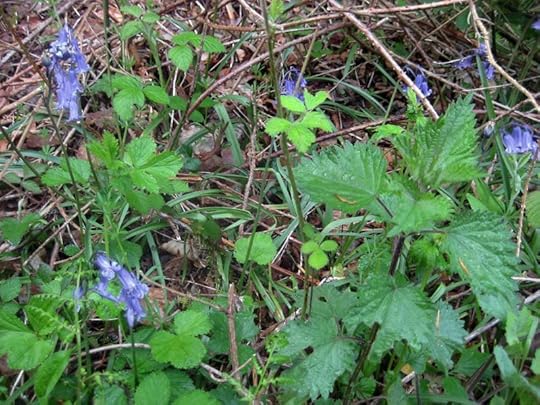 Nettles growing in the woods, with bluebells
Nettles growing in the woods, with bluebells
 Freshly picked nettle tips, with columbine
Freshly picked nettle tips, with columbine
 Tilly, wildflowers, and a basket of nettles in the studio garden
Tilly, wildflowers, and a basket of nettles in the studio garden
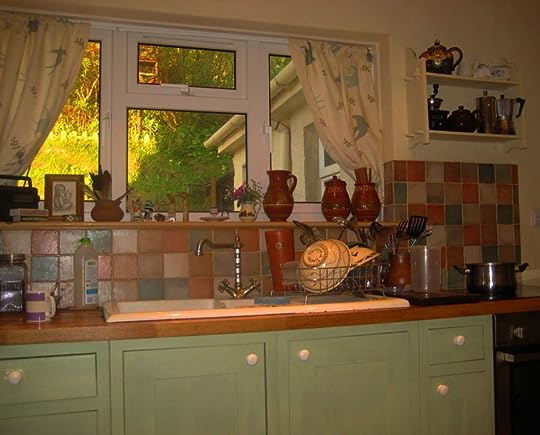 Golden evening light out the kitchen window
Golden evening light out the kitchen window
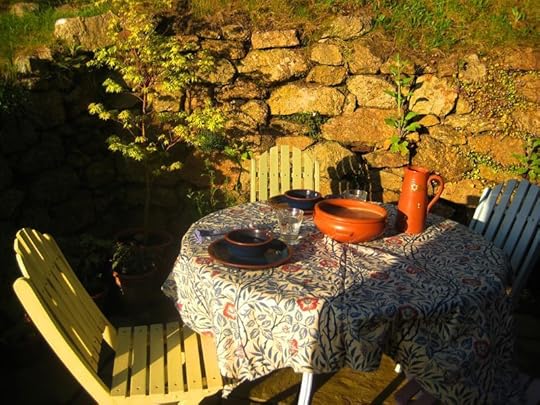 Soup for supper in the gold evening light...
Soup for supper in the gold evening light...
 ...watched over by Our Lady of Bumblehill (a statue made by Wendy Froud)
...watched over by Our Lady of Bumblehill (a statue made by Wendy Froud)
* If you look very, very closely in the "pot of soup" picture, you'll see the beginning pencil lines for a Bunny Girls mural on the wall above the kitchen hearth
This weekend...
May 23, 2012
The advice of a master
In relation to yesterday's question, Frank Lloyd Wright believed that these were the most important assets for the young architects who studied under him to cultivate:
1. An honest ego in a healthy body
2. An eye to see nature
3. A heart to feel nature
4. Courage to follow nature
5. A sense of proportion (humor)
6. Appreciation of work as idea and idea as work
7. Fertility of imagination
8. Capacity for faith and rebellion
9. Disregard for commonplace (inorganic) elegance
10. Instinctive cooperation
“Study nature, love nature, stay close to nature," he told them. "It will never fail you.”
The dialogue of flowers
"The artist is the confidant of nature, flowers carry on dialogues with him through the graceful bending of their stems and the harmoniously tinted nuances of their blossoms. Every flower has a cordial word which nature directs towards him." - Auguste Rodin
"I perhaps owe having become a painter to flowers." - Claude Monet
 Painting: "Poppy Fields near Argenteuil" by Claude Monet. Photographs: Nattadon Hill.
Painting: "Poppy Fields near Argenteuil" by Claude Monet. Photographs: Nattadon Hill.
May 22, 2012
When you fear you're just no good....
“Nobody tells this to people who are beginners, I wish someone told me. All of us who do creative work, we get into it because we have good taste. But there is this gap. For the first couple years you make stuff, it’s just not that good. It’s trying to be good, it has potential, but it’s not. But your taste, the thing that got you into the game, is still killer. And your taste is why your work disappoints you.
"A lot of people never get past this phase, they quit. Most people I know who do interesting, creative work went through years of this. We know our work doesn’t have this special thing that we want it to have. We all go through this. And if you are just starting out or you are still in this phase, you gotta know its normal and the most important thing you can do is do a lot of work. Put yourself on a deadline so that every week you will finish one story. It is only by going through a volume of work that you will close that gap, and your work will be as good as your ambitions. And I took longer to figure out how to do this than anyone I’ve ever met. It’s gonna take awhile. It’s normal to take awhile. You’ve just gotta fight your way through.” - Ira Glass
These are very true words, and I certainly wish someone had said them to me. I would have agonised less about the huge distance between the complex visions in my imagination and what I was able to put on the page in drawings and text. That distance never completely goes away...but it does get steadily smaller with time, hard work, and experience. In a youth-obsessed culture that over-emphasises early genius and the glamor of overnight success, it's good to remind young people beginning their artistic lives that you don't have to show up at the table as the artist you're going to be, you grow and work yourself into that artist. You unfold into that artist over years and decades.
If you could go back and speak to your younger self, or your beginning self, what would your advice be...?
Picture above: a drawing from my early days of making art, back in Boston in the 1980s
Terri Windling's Blog
- Terri Windling's profile
- 707 followers










